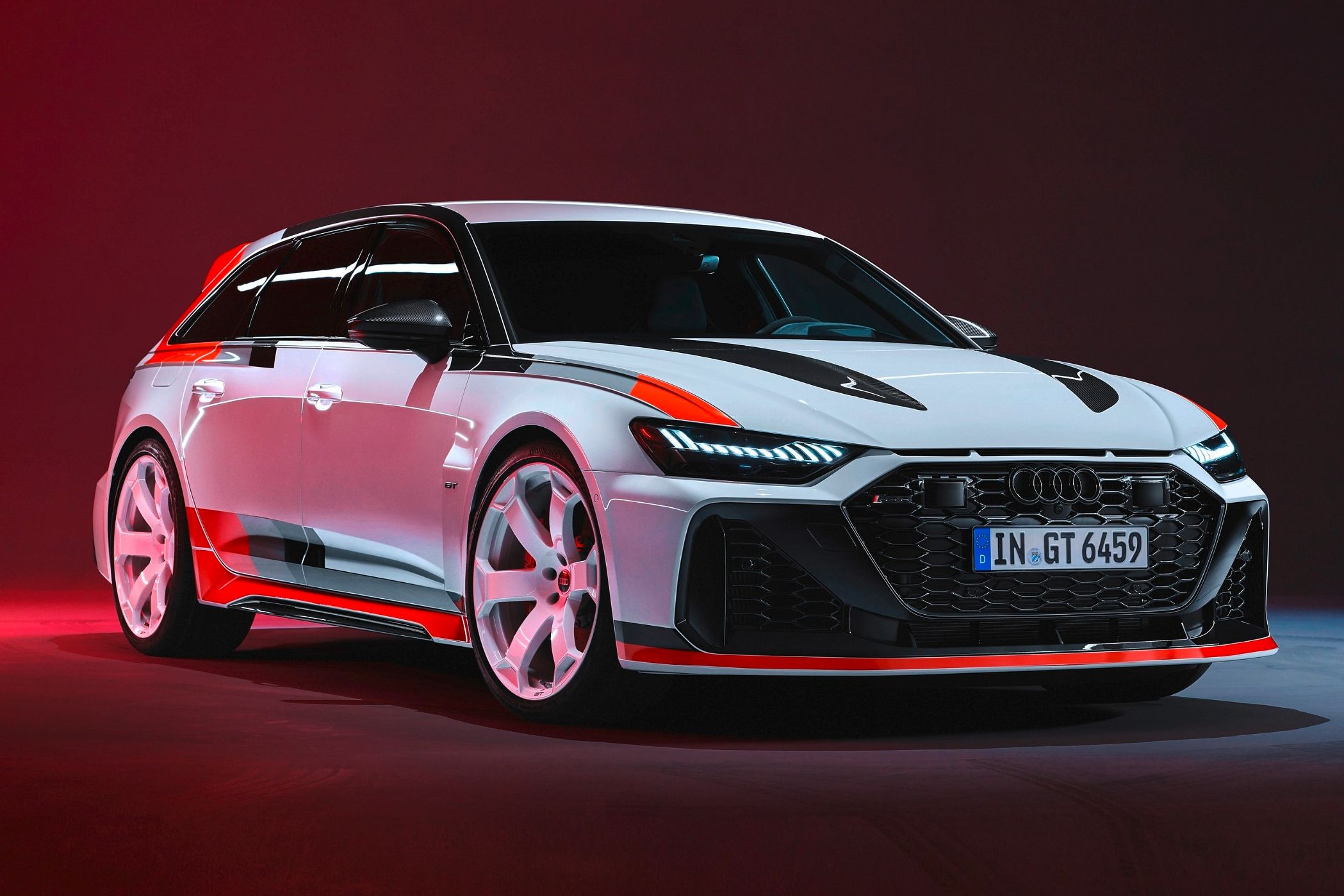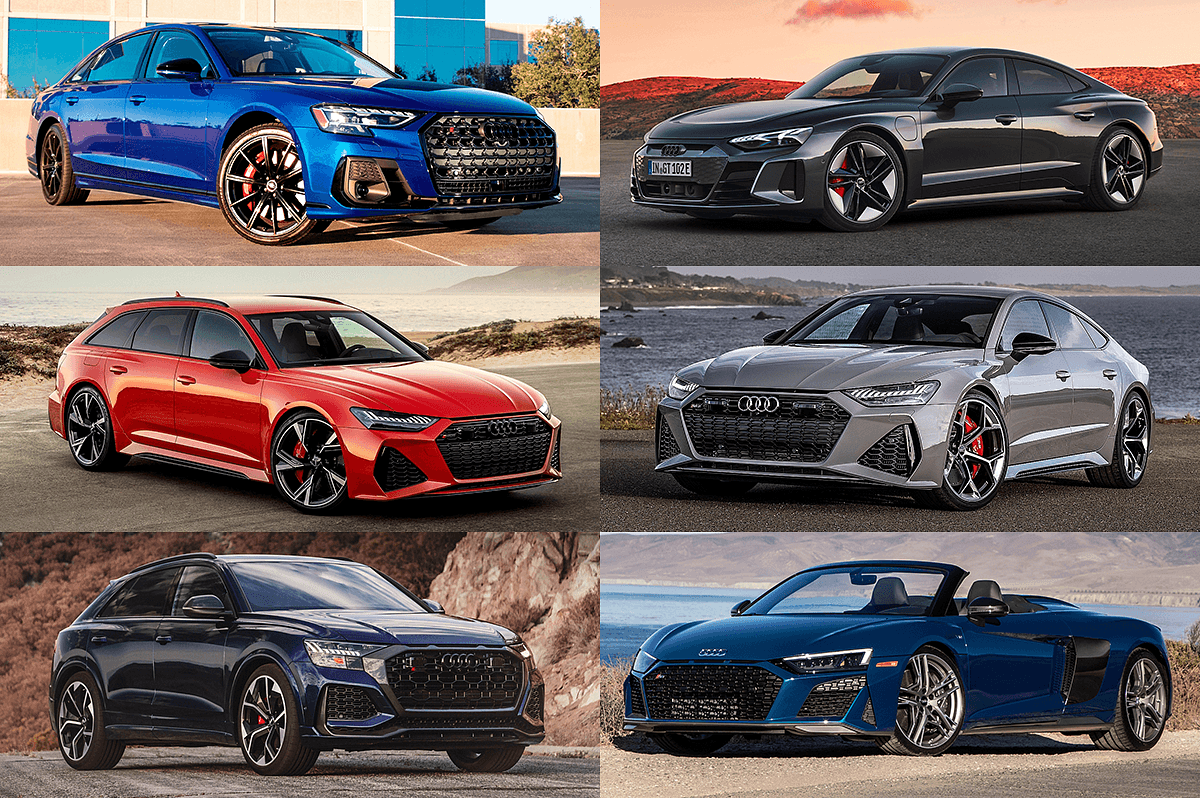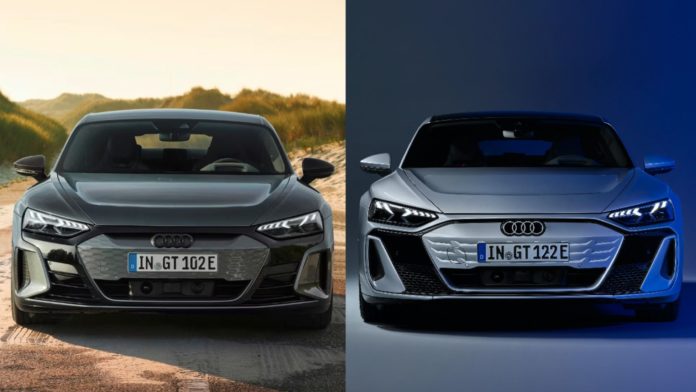Key Takeaways
- The 2025 RS e-tron GT boasts a major power increase, reaching a maximum output of 844 hp and an even more powerful RS e-tron GT Performance model at 912 hp. Both models feature improved brakes and battery technology.
- The sportier design of the RS e-tron GT includes an aggressive front end with an Audi Singleframe grille and unique L-shaped blades. The rear end features a streamlined diffuser. The RS e-tron GT Performance stands out with exclusive design elements.
- The interior of the e-tron GT has been upgraded for sportiness and luxury, featuring sustainable materials like Dinamica microfiber. The car is packed with state-of-the-art tech, including an MMI display with exclusive features and an Audi Connect package.
The e-tron GT is Audi’s first fully electric sedan and its third fully electric vehicle after the Q8 e-tron and Q8 e-tron Sportback (formerly known as only the e-tron). The original prototype for the e-Tron GT was revealed at the 2018 Los Angeles Auto Show and then at the Geneva Motor Show the following year. The production car went on sale for the 2020 model year, but it wasn’t until 2021 that Audi introduced the sportier RS version, which could accelerate from 0-62 mph in 3.3 seconds and reach a top speed of 155 mph. It has a lot in common with the Porsche Taycan, which received a significant overhaul earlier this year and a new trim called the Turbo GT.
Related
2025 Porsche Taycan Turbo GT Arrives As 1,092-HP Electric Track Slayer
Tesla and Lucid are about to be put on notice.
Now, three years after the model was first introduced, a refreshed version of the Audi RS e-tron GT is on its way for 2025. This update isn’t just a minor facelift: every aspect of the car, from driving experience to power to design, has been reworked and brought up to date. The lineup has changed as well, with three new trim levels: the S e-tron GT, followed by the updated RS e-tron GT, and last of all, the RS e-tron GT Performance, a new addition for the 2025 model year. Let’s focus on the last two and explore some of the improvements this model refresh has brought to the RS e-tron GT lineup:
1 Better Motor And Battery Performance
The biggest improvement for the 2025 RS e-tron GT comes on the power output front. While the 2024 model produced a maximum of 637 hp, the upcoming model has a maximum output of 844 hp. The RS e-tron GT Performance is even more powerful, with a power output of 912 hp. The new e-tron GT doesn’t just go faster; it also stops faster, thanks to its improved brakes (possibly borrowed from Porsche, if this test mule is anything to go by). Both RS models come with tungsten carbide-coated brake discs, while on the S e-tron GT they are available as an option.
The battery technology has also made leaps and bounds, with the maximum charging power increased by 50 kW to 320 kW. This means that the high-voltage battery found in the entire e-tron GT lineup can, under ideal conditions, charge from 10% to 80% in just 18 minutes when using a high-speed charging station. In a matter of 10 minutes, the battery can be charged to give you a driving range of 174 miles, and the Plug&Charge system automatically recognizes and authorizes compatible charging stations as soon as you plug your car in, which makes the charging process even more seamless. The battery’s weight has also been reduced to 1,378 pounds. A regenerative braking system, which can be controlled by the driver, can now recuperate more energy (400 kW as opposed to last year’s model’s 290 kW).
2 A Sportier Design
The improvements in performance are also reflected in the RS e-tron GT’s design, which is sportier and more aggressive to reflect the car’s character. The front end features an inverted version of Audi’s iconic Singleframe grille, with a honeycomb design that has an instant visual association with RS models. A black mask framed by an apron completes the front end, giving the RS e-tron GT a more expressive look, while the L-shaped blades on the front bumper (body-colored as standard) add an extra dose of aggressiveness. The car’s rear end is equally full of character, with a streamlined diffuser that echoes the styling cues found in the front.
3 A Brand New Performance Version
The fastest and most powerful version of the e-tron GT, the RS e-tron GT Performance, is a brand-new addition to the family for 2025. This is the first all-electric RS Performance model and makes sure to set itself apart from the standard RS e-tron GT with a host of unique, sportier design elements. An optional matte, darkened carbon roof is exclusive to the RS Performance; some optional carbon camouflage elements (on the door trim, diffuser, side mirrors, and bumper) are only available on the RS Performance as well.

Related
912-HP Audi RS e-tron GT Performance Is Audi’s Most Powerful Car Yet
The new electric GT is part of a three-car lineup that has received upgraded suspension, styling, technology, and a lighter battery.
In terms of, well, performance, the RS Performance comes with a host of mechanical upgrades that make it the most powerful production car Audi has ever built, with a power output of 925 PS (just over 912 hp). The front axle’s power electronics have been reworked to maximize power delivery, with a revised pulse inverter for even higher discharge currents. There is also a dedicated performance mode, not available on any other trim: this is entirely designed for track driving and optimizes the car’s setup to handle even the most challenging circuits with ease. This, of course, is in addition to the two individually customizable driving modes also available on the “regular” RS, called RS1 and RS2.
4 An Upgraded Interior
The interior has been given a series of upgrades as well, focusing on sportiness, comfort, luxury, and sustainability. The whole e-tron GT range comes with new wooden inlays made of anthracite-colored birch; in the RS e-tron GT Performance, these inlays can also be had in matte carbon camouflage, which echoes the color of the optional body elements also exclusive to the Performance model. A finish called Vanadium, whose anthracite color appears differently depending on the way the light hits it, is used in several applications throughout the interior; while in the S e-tron GT, this finish is available as an optional extra. In the RS and RS Performance versions, it comes as standard.

Related
6 Reasons Why The 2025 RS6 Avant GT Is Audi’s Best Station Wagon Yet
Here’s how you become the fastest parent on the school run.
The steering wheel is now flattened at the top and bottom, taking visual cues from motorsport; in the RS models, it has further design features, including two red control buttons and an optional 12 o’clock marking.
Being an electric vehicle, the e-tron GT had to feature a nod to sustainability and eco-friendly driving. The interior makes heavy use of a sustainable microfiber material called Dinamica (around 37 to 45 percent of each e-tron GT’s interior is made of Dinamica, including the seats, steering wheel, door mirrors, and center console), which, in the RS models, is features in deep black. Dinamica is made out of nearly 50% recycled polyester, part of which is sourced from fabric scraps. The finished material looks and feels like suede.
5 Packed With State-Of-The-Art Tech
The e-tron’s character as a model is extremely high-tech and futuristic, and this refreshed version is no exception. The car’s infotainment system comes with the Audi Connect package, which includes a wealth of connectivity features that allow you to check your car’s health, get help in case of an emergency, get navigation directions, and even turn your car into a Wi-Fi hotspot. Audi’s MMI (Multi Media Interface) display comes with some additional exclusive features on the RS e-tron GT and RS e-tron GT performance: in the latter, for example, the driver can select a white background for the display and speedometer.

Related
Most Expensive Audi Models You Can Buy In America
From EVs to brawny V8s, Audi has many options for the wealthy.
This is an homage to Audi’s history, specifically the history of the high-performance RS brand: the 1994 Audi RS 2 Avant, the very first model Audi produced to feature the RS badge, was equipped with analog dials in white.
The e-tron’s virtual cockpit provides the driver with information about the battery’s real-time maximum possible charging power and battery temperature. The infotainment system also controls an optional panoramic roof made of “smart glass,” which can turn opaque at the touch of a button to minimize direct sunlight. One of the preset options for the smart sunroof comes with a graphic pattern that evokes Audi’s iconic honeycomb pattern.

